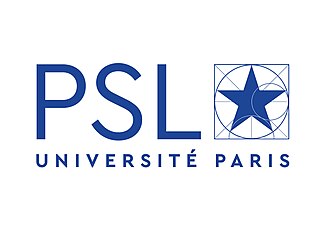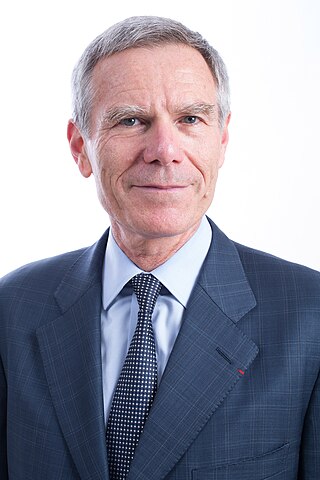
The École nationale d'administration was a French grande école, created in 1945 by President Charles de Gaulle and principal author of the 1958 Constitution Michel Debré, to democratise access to the senior civil service. It was abolished on 31 December 2021 and replaced by the Institut national du service public (INSP).

ENSAE Paris is a university in France, known as Grandes Ecoles and a member of IP Paris. ENSAE Paris is known as the specialization school of École polytechnique for economics, finance, applied mathematics, statistics, and data science. It is one of France's top engineering schools and is directly attached to France's Institut national de la statistique et des études économiques (INSEE) and the French Ministry of Economy and Finance.

Bruno Mégret is a French former nationalist politician. He was the leader of the Mouvement National Républicain political party, but retired in 2008 from all political action.
The Corps des ponts, des eaux et des forêts is a technical Grand Corps of the French State. Its members are senior officials, mainly employed by the French Ministry of Environment and Energy and by the Ministry of Agriculture. Most of them are from École polytechnique, where they are selected based on their ranking, and from AgroParisTech where they are selected based on an entrance exam, others are from École normale supérieure (Ulm) or the regular curriculum of the École des ponts ParisTech.

Mines Paris – PSL, officially École nationale supérieure des mines de Paris, is a French grande école and a constituent college of PSL Research University. It was originally established in 1783 by King Louis XVI.

Mines Nancy is one of the leading French engineering Grandes Écoles.

Félix Savart was a French physicist and mathematician who is primarily known for the Biot–Savart law of electromagnetism, which he discovered together with his colleague Jean-Baptiste Biot. His main interest was in acoustics and the study of vibrating bodies. A particular interest in the violin led him to create an experimental trapezoidal model. He gave his name to the savart, a unit of measurement for musical intervals, and to Savart's wheel—a device he used while investigating the range of human hearing.

Collège des Ingénieurs is a European educational institution and business school founded in Paris (France), Munich (Germany), and Turin (Italy). It provides engineering graduates with learning opportunities in business administration and finance, in order for them to develop the key skills and competencies required to succeed in the corporate environment and to take up executive positions.

The Institut Supérieur de l'Aéronautique et de l'Espace is a French grande école of engineering, founded in 1909. It was the world's first dedicated aerospace engineering school and is considered to be the best in Europe in the field. The school delivers a range of science and engineering degree programs. ISAE-SUPAERO is part of University of Toulouse, ISSAT, PEGASUS, GEA, Toulouse Tech, CESAER and Aerospace Valley.

Alexandre-Émile Béguyer de Chancourtois was a French geologist and mineralogist who was the first to arrange the chemical elements in order of atomic weights, doing so in 1862. De Chancourtois only published his paper, but did not publish his actual graph with the irregular arrangement. Although his publication was significant, it was ignored by chemists as it was written in terms of geology. It was Dmitri Mendeleev's table published in 1869 that became most recognized. De Chancourtois was also a professor of mine surveying, and later geology at the École Nationale Supérieure des Mines de Paris. He also was the Inspector of Mines in Paris, and was widely responsible for implementing many mine safety regulations and laws during the time.
ParisTech is a cluster that brings together 7 renowned grandes écoles based in Paris, France. It covers the whole spectrum of science, technology and management and has more than 12.000 students.
The Corps des télécommunications was a French Technical "grand corps de l'Etat". It is formed of the State Engineers of the Telecommunications.

Paris Sciences et Lettres University is a public research university based in Paris, France. It was established in 2010 and formally created as a university in 2019. It is a collegiate university with 11 constituent schools, with the oldest founded in 1530. PSL is located in central Paris, with its main sites in the Latin Quarter, at the Montagne Sainte-Geneviève campus, at the Jourdan campus, at Porte Dauphine, and at Carré Richelieu.

The Conférence des Grandes Écoles (CGE), French for "Conference of Grandes Écoles", is a French national institution, created in 1973. It mainly acts as an association of Grandes Écoles, providing representation, research and accreditation. A Grande école is a French institution of higher education that is separate from, but parallel and often connected to, the main framework of the French public university system. Grandes écoles are elite academic institutions that admit students through an extremely competitive process, and a significant proportion of their graduates occupy the highest levels of French society. Similar to Ivy League schools in the United States, Russel Group in the UK, and C9 League in China, graduation from a grande école is considered the prerequisite credential for any top government, administrative and corporate position in France.

The Corps de l'armement, or corps des ingénieurs de l'armement is a Technical Grand Corps of the French State, aimed at providing the French Armed Forces with all appropriate equipment and at supervising the French Aerospace & Defence industry.

Jacques Biot is a French engineer, businessman, lobbyist for pharmaceutical companies and academic administrator. He serves as the president of the École Polytechnique between 2013 and 2018.

Pierre Pringuet is a French businessman. He was the chief executive officer of Pernod-Ricard from 2008 to 2015. He serves as its vice president, as well as the president of the French Association of Private Enterprises (AFEP).
COUPERIN is an academic consortium in France. Formed in 1999, it includes more than 250 universities, research organizations, Grandes écoles (schools), COMUE, and others. The consortium negotiates with publishers the prices and conditions of access to scientific publications and other digital resources for the benefit of its members. It promotes open science, particularly with regard to scientific publications, both nationally and internationally. It is headquartered in Paris.
















